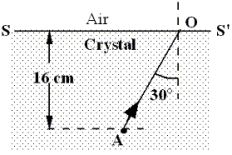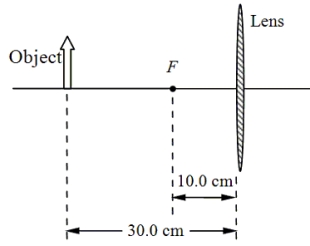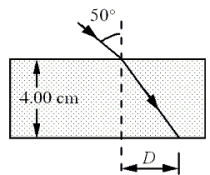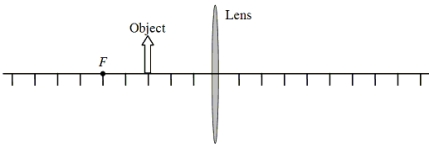A) 0.37°
B) 0.65°
C) 22°
D) 41°
E) 60°
G) B) and E)
Correct Answer

verified
Correct Answer
verified
Multiple Choice
Which one of the following statements concerning the index of refraction for a given material is true?
A) The index of refraction may be less than 1.
B) The index of refraction may be measured in nanometers.
C) The index of refraction does not depend on the frequency of the incident light.
D) For a given frequency, the index of refraction is inversely proportional to the wavelength of light in vacuum.
E) For a given frequency, the index of refraction is inversely proportional to the wavelength of light in the material.
G) A) and B)
Correct Answer

verified
Correct Answer
verified
Multiple Choice
Which one of the following statements is true concerning the focal length of a lens?
A) The focal length is the same for all colors.
B) The focal length is different for different colors because of reflection.
C) The focal length is different for different colors because of dispersion.
D) The focal length is different for different colors because of polarization.
E) The focal length is different for different colors because of spherical aberration.
G) D) and E)
Correct Answer

verified
Correct Answer
verified
Multiple Choice
A ray of light originates in medium A and is incident upon medium B. For which one of the following pairs of indices of refraction for A and B is total internal reflection not possible? 
A) ![]()
B) ![]()
C) ![]()
D) ![]()
E) ![]()
G) C) and D)
Correct Answer

verified
Correct Answer
verified
Multiple Choice
The right lens of Josh's contact lenses is a converging lens of +2.50 diopters. He can read a book held as close as 25 cm from his eyes. Complete the following statement: Without his lenses, Josh's right eye has
A) a far point of 15.4 cm.
B) a far point of 40.0 cm.
C) a far point of 66.7 cm.
D) a near point of 15.4 cm.
E) a near point of 66.7 cm.
G) A) and C)
Correct Answer

verified
Correct Answer
verified
Multiple Choice
In a scene from a movie, a nearsighted character removes his eyeglasses and uses them to focus the nearly parallel rays of the sun to start a fire. What is physically wrong with this scene?
A) The eyeglasses have diverging lenses and cannot be used to focus parallel rays.
B) The eyeglasses have converging lenses and cannot be used to focus parallel rays.
C) Sunlight cannot be used to start a fire.
D) A fire can only be started if the image is virtual.
E) Parallel rays cannot be focused.
G) B) and C)
Correct Answer

verified
Correct Answer
verified
Multiple Choice
Rachel has a far point of 5 m. Which statement below concerning Rachel's vision is true?
A) She has normal vision.
B) She is myopic and requires diverging lenses to correct her vision.
C) She is myopic and requires converging lenses to correct her vision.
D) She is hyperopic and requires diverging lenses to correct her vision.
E) She is hyperopic and requires converging lenses to correct her vision.
G) A) and E)
Correct Answer

verified
Correct Answer
verified
Multiple Choice
The figure shows a point source of unpolarized light at A inside a uniform transparent crystal. The ray AO in the crystal strikes the plane surface SS' making an angle of 30° with the normal. This angle is the critical angle for transmission into air.  -If point A is 16 cm below the plane SS', what is the radius of the largest circle at the air-crystal interface through which light can emerge from the crystal?
-If point A is 16 cm below the plane SS', what is the radius of the largest circle at the air-crystal interface through which light can emerge from the crystal?
A) 9.2 cm
B) 16.0 cm
C) 18.4 cm
D) 27.0 cm
E) 32.0 cm
G) A) and B)
Correct Answer

verified
Correct Answer
verified
Multiple Choice
Light that is incident upon the eye is refracted several times before it reaches the retina. As light passes through the eye, at which boundary does the majority of the overall refraction occur?
A) lens/aqueous humor
B) air/cornea
C) lens/vitreous humor
D) aqueous humor/iris
E) vitreous humor/retina
G) B) and D)
Correct Answer

verified
Correct Answer
verified
Multiple Choice
When an object is placed 25 cm from a lens, a real image is formed. Which one of the following conclusions is incorrect?
A) The image is upright.
B) The lens is a converging lens.
C) The image may be reduced or enlarged.
D) The image distance can be less than 25 cm.
E) The focal length of the lens is less than 25 cm.
G) All of the above
Correct Answer

verified
Correct Answer
verified
Multiple Choice
An object is placed at the focal point of a thin diverging lens of focal length f. What is the image distance?
A) f
B) 2f
C) 1/f
D) f/2
E) at an infinite distance
G) B) and E)
Correct Answer

verified
Correct Answer
verified
Multiple Choice
A 4.0-cm object is placed 30.0 cm from a converging lens that has a focal length of 10.0 cm as shown in the diagram. Note: The diagram is not drawn to scale.  -Determine the height and orientation of the image.
-Determine the height and orientation of the image.
A) 2 cm and upright
B) 1 cm and inverted
C) 2 cm and inverted
D) 8 cm and upright
E) 8 cm and inverted
G) B) and D)
Correct Answer

verified
Correct Answer
verified
Multiple Choice
A 4.0-cm object is placed 30.0 cm from a converging lens that has a focal length of 10.0 cm as shown in the diagram. Note: The diagram is not drawn to scale.  -A second converging lens is placed 20.0 cm to the right of the lens shown in the figure. Determine the focal length of the second lens if an inverted image (relative to the object in the diagram) is formed 13.3 cm to the right of the first lens.
-A second converging lens is placed 20.0 cm to the right of the lens shown in the figure. Determine the focal length of the second lens if an inverted image (relative to the object in the diagram) is formed 13.3 cm to the right of the first lens.
A) 1.33 cm
B) 6.67 cm
C) 13.3 cm
D) 15.4 cm
E) 19.7 cm
G) B) and C)
Correct Answer

verified
Correct Answer
verified
Multiple Choice
White light enters a glass prism, but the color components of the light are observed to emerge from the prism. Which one of the following statements best explains this observation?
A) The separation of white light into its color components is due to the increase in the speed of light within the glass.
B) Some of the color components of the white light are absorbed by the glass and only the remaining components are observed.
C) The index of refraction of the glass depends on the wavelength, so the color components are refracted at different angles.
D) Only some of the color components are refracted by the glass; and these are the ones that are observed.
E) White light is separated into its color components by total internal reflection within the prism.
G) A) and E)
Correct Answer

verified
Correct Answer
verified
Multiple Choice
Light with a wavelength of 589 nm in a vacuum strikes the surface of an unknown liquid at an angle of 31.2° with respect to the normal to the surface. If the light travels at a speed of 1.97 × 108 m/s through the liquid, what is the angle of refraction?
A) 19.9°
B) 26.1°
C) 34.2°
D) 39.3°
E) 51.9°
G) B) and C)
Correct Answer

verified
Correct Answer
verified
Multiple Choice
A 1.5-cm object is placed 0.50 m to the left of a diverging lens with a focal length of 0.20 m. A converging lens with a focal length of 0.17 m is located 0.08 m to the right of the diverging lens. -What is the location of the final image with respect to the object?
A) The final image is located 0.14 m to the left of the object.
B) The final image is located 0.32 m to the right of the object.
C) The final image is located 0.40 m to the right of the object.
D) The final image is located 0.83 m to the right of the object.
E) The final image is located 1.3 m to the right of the object.
G) B) and E)
Correct Answer

verified
Correct Answer
verified
Multiple Choice
Joseph uses a converging lens (f = 0.12 m) to read a map located 0.080 m from the lens. What is the magnification of the lens?
A) +3.4
B) +3.0
C) +1.7
D) +0.60
E) +0.33
G) A) and D)
Correct Answer

verified
Correct Answer
verified
Multiple Choice
A ray of light passes from air into a block of glass with a refractive index of 1.59 as shown in the figure. Note: The drawing is not to scale.  What is the value of the distance D?
What is the value of the distance D?
A) 1.42 cm
B) 1.66 cm
C) 1.93 cm
D) 2.19 cm
E) 2.38 cm
G) A) and B)
Correct Answer

verified
Correct Answer
verified
Multiple Choice
A ray of light propagates in water (n = 1.333) and strikes a sheet of crown glass (n = 1.523) . If the angle of refraction in the glass is 35.2°, determine the angle of incidence.
A) 30.3°
B) 32.8°
C) 35.2°
D) 41.2°
E) 45.0°
G) A) and B)
Correct Answer

verified
Correct Answer
verified
Multiple Choice
The figure is a scaled diagram of a an object and a converging lens. The focal length of the lens is 5.0 units. An object is placed 3.0 units from the lens as shown.  -What is the total magnification of this lens combination?
-What is the total magnification of this lens combination?
A) +1/2
B) -1/2
C) +1
D) -1
E) +2
G) B) and D)
Correct Answer

verified
Correct Answer
verified
Showing 21 - 40 of 102
Related Exams